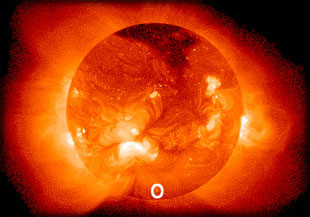|
|
|||||
|
What Parts to Paint? |
|
||||
In order to look for an x-ray area-to-sunspot correlation you need to know what parts of each image to "paint." In the visible light images it's fairly obvious where the sunspots are, but what about the x-ray images? |
||
|
||
| A word about the colors Can you identify the active areas using the image colors? Remember: the colors are representations of light that our eyes cannot see. This means that any colors that appear in the images are the result of a decision by the person who created the image from a file of numbers: the numbers of x-rays in each pixel. For each type of image, there is a key, or standard, that identifies which color represents each number or range of numbers. What is important for your work is the fact that the same color choices were made for each of the x-ray images, and for each of the the white light images. |
||
|
||
|
||
| For more information on the loops, plumes, and various other features you see in x-ray images, you can go to this page in the archive of Yohkoh images: SXT image features. (new window opens) |
|
|
|||||
|
|
|||||
|
ęCopyright 2001 Regents of the University of California. |


